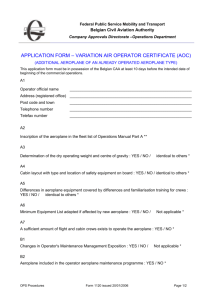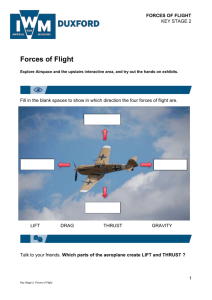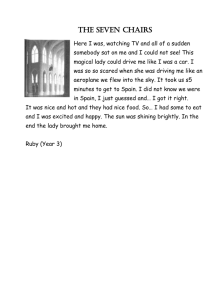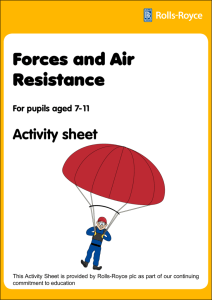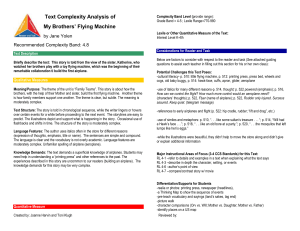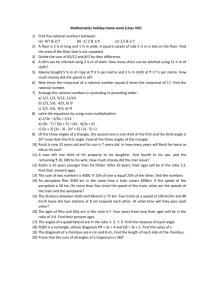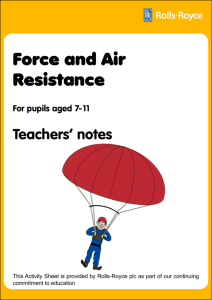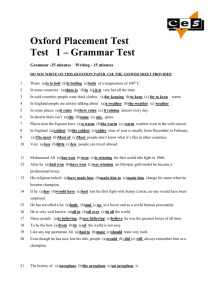Yak 52 Airworthiness Approval Note: G-YAKS Permit to Fly
advertisement
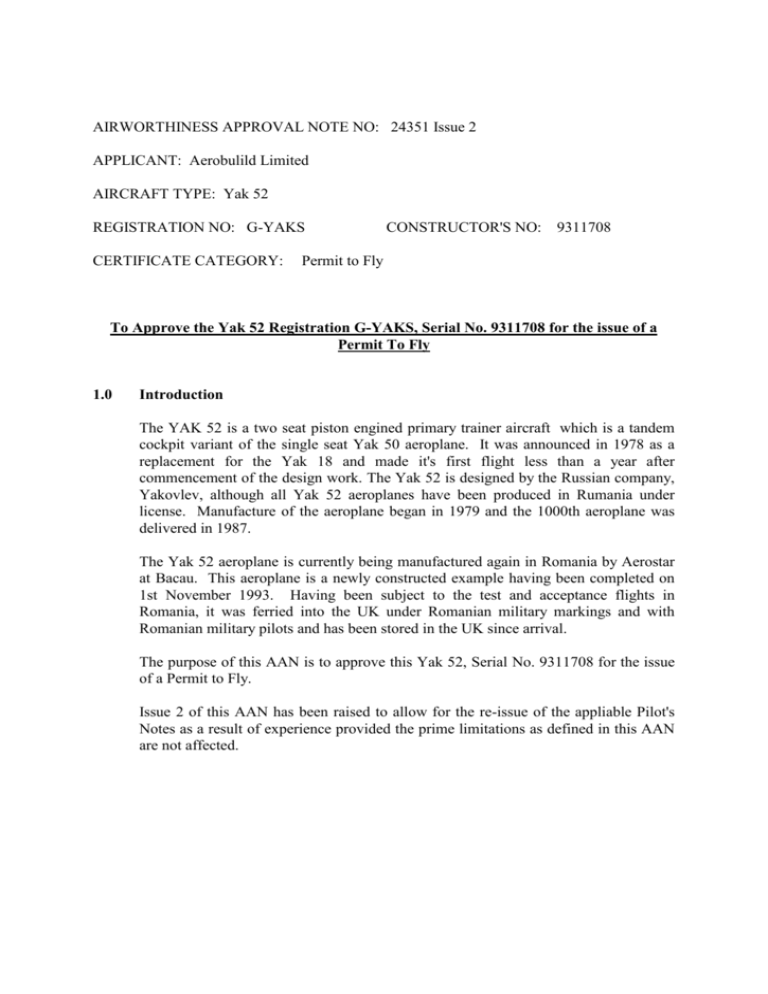
AIRWORTHINESS APPROVAL NOTE NO: 24351 Issue 2 APPLICANT: Aerobulild Limited AIRCRAFT TYPE: Yak 52 REGISTRATION NO: G-YAKS CERTIFICATE CATEGORY: CONSTRUCTOR'S NO: 9311708 Permit to Fly To Approve the Yak 52 Registration G-YAKS, Serial No. 9311708 for the issue of a Permit To Fly 1.0 Introduction The YAK 52 is a two seat piston engined primary trainer aircraft which is a tandem cockpit variant of the single seat Yak 50 aeroplane. It was announced in 1978 as a replacement for the Yak 18 and made it's first flight less than a year after commencement of the design work. The Yak 52 is designed by the Russian company, Yakovlev, although all Yak 52 aeroplanes have been produced in Rumania under license. Manufacture of the aeroplane began in 1979 and the 1000th aeroplane was delivered in 1987. The Yak 52 aeroplane is currently being manufactured again in Romania by Aerostar at Bacau. This aeroplane is a newly constructed example having been completed on 1st November 1993. Having been subject to the test and acceptance flights in Romania, it was ferried into the UK under Romanian military markings and with Romanian military pilots and has been stored in the UK since arrival. The purpose of this AAN is to approve this Yak 52, Serial No. 9311708 for the issue of a Permit to Fly. Issue 2 of this AAN has been raised to allow for the re-issue of the appliable Pilot's Notes as a result of experience provided the prime limitations as defined in this AAN are not affected. 2.0 Basis of Approval This aeroplane is a later produced example of the same type granted a Permit to fly by virtue of the issue of AAN 24089. The basis of approval for this aeroplane is the extensive operating experience of the type as a basic training aeroplane for the Russian military (over 1000 examples of this type have been produced), together with an investigation of the design standard and operational aspects of the aeroplane. 3.0 Description The Yak 52 is a single engined two seat (tandem configuration) low wing primary trainer aeroplane of nominally all-metal construction with full aerobatic capability. The fuselage is of a conventional light alloy semi-monocoque construction with a cantilever light alloy tail structure. The wings are of a single spar all metal stressed skin construction with trailing edge split flaps. The control surfaces are fabric covered. There is a ground adjustable tab on each aileron and on the rudder and a controllable tab in the port elevator. The landing gear is semi-retractable and is pneumatically operated. The nose gear retracts rearwards and the main gear forwards but all remain exposed against the undersurface of the aeroplane to offer greater safety in the event of a wheels up landing. Emergency operation of the landing gear is via an independent pneumatic system which is charged on the ground. The brakes system is also operated by the pneumatic system which operates at a pressure of 50 bars (720 psi). The aeroplane is powered by a nine cylinder Vedeneyev M-14P air cooled radial engine of nominally 360 hp manufactured by Ivchenko. This engine has a fully inverted fuel and oil system. The propeller is a two blade variable pitch (type V530TA-D35). Cowl flaps are fitted to assist in the warming up of the engine by selecting them closed. Once at running temperatures, they must be selected open. The controls are in the front cockpit which is the "command" cockpit. The fuel system consists of two tanks in the wings, each of 60 litres capacity feeding a small collector tank in the fuselage. The engine draws it's fuel from the collector tank. There is a single on-off fuel cock in each cockpit. Engine priming is accomplished by a a two position injector pump operated from the front cockpit. A fuel drain is provided under the aircraft centre section and drains from the collector tank. The electrical system is supplied by a nominal 28 volt engine driven generator with an associated voltage regulator. The system is protected by a circuit breaker. A Varley battery is installed in the port wing and there are two static inverters providing AC power for additional services. 2 4.0 Technical Investigation. This aeroplanes a newly produced example of the Yak 52 and was imported into the UK direct from the manufacturer on Romanian military markings post the factory test flights and acceptance flights. This aeroplane has completed 15:05 hours and 16 landings at the time of compiling this AAN. The generic design of this aeroplane is accepted on the basis that there have been over 1000 Yak 52 aeroplanes manufactured and by virtue of the fact that there is no evidence of an unsatisfactory safety record of the type. The applicant submitted a aircraft data sheet (Specification) dated September 1993 generated by the aircraft manufacturer as part of the approval of the first aeroplane (See AAN 24089), which defines the basic physical characteristics of the aeroplane including basic equipment and airframe limitations. This specification is applicable to this aeroplane. A number of modifications generated by the applicant for approval of the first aeroplane, to address CAA concerns regarding some specific design features have been incorporated in this aeroplane. These modifications are applicable to this aeroplane and are considered acceptable: Modification No. YAK/01/AEROBUILD YAK/02/AEROBUILD YAK/03/AEROBUILD YAK/04/AEROBUILD YAK/05/AEROBUILD Description To disable the simulated failure switches (rear cockpit) To disable the starter isolation switch (rear cockpit) To disable the brake arming switch (rear cockpit) To disable flap operation from rear cockpit To disable undercarriage operation from rear cockpit The original 'Varley' Battery is not suitable for aerobatics unless drained of acid prior to each flight. It has been replaced by two smaller "Hitachi" batteries in accordance with a customer modification approved as a minor modification. Applicants modification YAK 07 AEROBUILD, Replacement of Varley Battery (CAA Minor Modification 9/217/9103AV refers). The English placarding and instrument markings have been installed by the manufacturer prior to export to the UK. The applicant has added placards and markings required by this AAN. This aspect has been reviewed by CAA as part of the inspection of the aeroplane and has found to be acceptable. The aeroplane, being a new machine from the factory is constructed to the latest build standard. The applicant has stated that there are no "Modernisation Bulletins" required to be installed on this aeroplane as all applicable bulletins are now part of the basic build standard. The applicant has submitted a letter from the aeroplane manufacturer in confirmation of this statement. 3 The data sheet for the aeroplane generated by the aircraft manufacturer defines a VNE of 450 km/hour for aeroplanes modified in accordance with their "Bulletins 59R and 60R". This aeroplane is modified in accordance with the above bulletins (by virtue of inclusion in the build standard) but the applicant has elected to use the premodification level of VNE of 420 km/hour for this aeroplane. The applicant has presented a list of lifed items applicable to the aeroplane as generated by the aircraft manufacturer. These lives (as follows) must be incorporated in the maintenance schedule for the aeroplane. Description Part Number Propeller Air Bottle Air Bottle Speed Indicator Gyrohorizon Indicator G Meter Vacuum Pressure Gauge Cylindrical Thermometers Fuel Pressure Transducers Oil Pressure Transducers Pressure Gauge Flexible pipes V530TA-D35 LM-375a-11-50 LM-375a-3-50 US-450K AGT-1K AM-9S MV-16K TTT-13 P-1B PM-15B 2M-80K as fitted Life Limit hrs/years 500/6 -/5 -/5 1000/5 500/6 2000/5 1500/6 6000/5 1000/4 1000/4 1000/4 -/5 The applicant provided a set of Pilot's Notes as part of the approval for the first aeroplane, compiled by himself and based upon a translation of the original Flight Manual supplied by the aircraft manufacturer. These notes have been amended to remove specific weight data allowing use on other aeroplanes and are now at Issue 2. These notes are considered acceptable for this aeroplane operating on a Permit to Fly. 5.0 Flight Test The first aeroplane was the subject of a flight test by CAA. The performance and handling of the aeroplane was considered to be acceptable. Flight Test Report FTR 8838P refers. This aeroplane has been flight tested by Mr M Jefferies to AFTS No.2 at issue 7 and was found to be satisfactory. The applicants flight test dated 20th December 1993 has been reviewed by CAA and is considered acceptable. 6.0 Weight and Balance This aeroplane was weighed by the aeroplane manufacturer, and the weight and balance information is defined in a schedule dated 15th December 1993, prepared by Yak UK. A pro-forma of this schedule is included in the Pilot's Notes submitted by the applicant for this aeroplane (See Section 7 of this AAN). 4 7.0 Pilot's Notes and Placards The applicant has prepared a set of Pilot's notes based on a translation of the original Flight Manual for the aeroplane as modified (Ref: Aerobuild Yakovlev Yak 52 Flight Manual AB/FA/52-1 at revision 2) which are considered acceptable. These notes were accepted at issue 2 for the issue of a Permit to Fly for this aeroplane. Later issues accepted by CAA are also considered appropriate provided the limitations as defined in this section of the AAN are not changed. Note: Revision 2 removes the specific aircraft weight information, replacing it with a proforma allowing the use of these notes on other aeroplanes of the same type. The following limitations shall apply: Maximum Take-off Weight *Manoeuvre load limits Centre of Gravity Limitations 1315 kg (2899 lbs) +7g/-5g One Pilot 17.5%-27% MAC Two Pilots 23%-27% MAC This corresponds to: 17.2cm -32.8cm forward of datum (One Pilot) 17.2cm -23.78 cm forward of datum (Two Pilots) Where the datum is a point 61.5 cm aft of the leading edge of the wing 210.8cm from the centreline of the aircraft. *Never Exceed Speed (VNE) *Maximum Manouvering Speed (VA) *Maximum Speed Flaps Extended (VFE) Maximum Speed Gear Extended (VLE) 420 km/hr (226 knots) 360 km/hr (162 knots) 170 km/hr (91 knots) 200 km/hr (108 knots) Solo flight from front cockpit only Aerobatics and spinning are permitted except as detailed below: Aerobatics are prohibited a) with Flaps and/or Landing gear extended b) With a fuel load is 20 litres or less Maximum permitted altitude 10,000 feet Powerplant Limitations: *Maximum RPM Maximum Continuous RPM (See also Pilot's Notes) 100% ( 5 minutes max.) 82% Those limitations above marked (*) must be indicated in both cockpits (where appropriate) by means of appropriate placards or instrument markings. Additional placards stating the non certified nature of this aeroplane must be installed in both cockpits and defined on the Permit to Fly 5 8.0 Radio Equipment Fitted BAKLAW 5 VHF COMMUNICATION The applicant has received Q approval (No. Q01088) for the above equipment under aerobuild Mod No. YAK09/Aerobuild. The aircraft has provision for the installation of a Russian ADF system but as this is unapproved at this time the equipment has been removed. 9.0 Maintenance The applicant has elected to use the maintenance schedule as recommended by the aircraft manufacturer. This schedule is defined as Aerobuild Yak 52 Maintenance Schedule ref: YAK 52 at issue 1 dated 17th December 1993. This schedule must include the list of lifed items as specified in Section 4 of this AAN. 10.0 Approval This Yak 52 Registration G-YAKS serial Number 9311708 as modified in accordance with this AAN is approved for the issue of a Permit to Fly provided it is operated in accordance with the limitations and conditions as stated in the Permit to Fly and provided it is maintained in accordance with the Maintenance Schedule as specified in Section 9.0 of this AAN. K Russell .................................................. For the Civil Aviation Authority Date 31 March 1995 6
